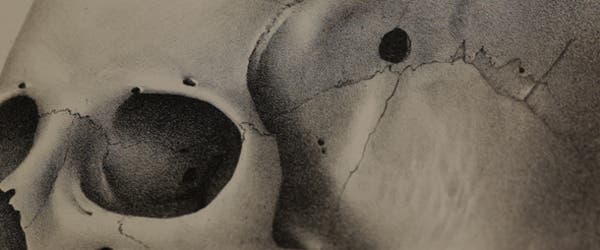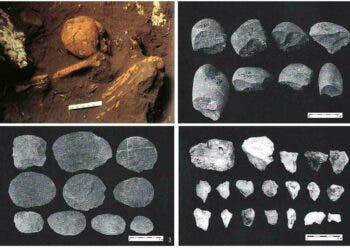For men of simple means and upbringing, it’s easy to credit racism: the other fellow is different from me – his skin is of another color, his hair is weird, his language sounds stupid. Racism has had a wicked role to play in society since antiquity, fueling the murders and enslaving of millions of people and culminating with the great holocausts of the XXth century. Racism doesn’t pertain to a certain upbringing or education, however. Even in the so-called enlightened times of the XIXth century, many of the world’s elite were self-professed racists, though maybe not by this exact terminology.

In 1839, Samuel George Morton published his magnum opus, the “Crania Americana”, a book that covers over 78 illustrations of skulls, from embalmed heads to bullet perforate skulls. The work is considered the most distinguished and thorough book on scientific racism. It opens with an elaborated division of mankind into five fundamental races, before explaining how each race poses a particular character related to its skull shape. Morton wrote of Native Americans that “the structure of his mind appears to be different from that of the white man”.
You may have heard about this sort of reasoning, which was so popular in the XIX century and later on. It’s called phrenology, a pseudoscience whose central theme is to relate bumps in the head with personality traits. Phrenology was developed by a German physician named Franz Joseph Gall in the late 1700s. Gall noticed that the cerebral cortex of humans was much larger than that of animals, which he believed was what made humans intellectually superior. Eventually, he became convinced that the physical features of the cortex could also be seen in the shape and size of the skull.
Science and racism
The core idea behind phrenology is that moral and intellectual abilities are totally innate, that the brain was composed of as many organs as there are different faculties, propensities and sentiments, and that the form of the skull represented and reflected the form and development of the brain organs.

I won’t go into too many details, but needless to say, Morton went a step further and applied this sort of reasoning not to individuals, but to whole races, after observing there were certain skull features that were a common function of race. Morton believed that cranial capacity, the size of the skull, gave an accurate measure of intelligence. The bigger your skull, the bigger your brain, the smarter you were, so Morton collected thousands of skulls and measured their cranial capacity. His study led him to claim, among other, that Native American skulls were actually of a different consistency to Europeans, and went on to describe them as a whole as “adverse to cultivation, and slow in acquiring knowledge.”
EXCERPT FROM THE BOOK
Europeans
“The Caucasian Race is characterized by a naturally fair skin, susceptible of every tint; hair fine, long and curling, and of various colors. The skull is large and oval, and its anterior portion full and elevated. The face is small in proportion to the head, of an oval form, with well-proportioned features. . . . This race is distinguished for the facility with which it attains the highest intellectual endowments. . . . The spontaneous fertility of [the Caucasus] has rendered it the hive of many nations, which extending their migrations in every direc-tion, have peopled the finest portions of the earth, and given birth to its fairest inhabitants. . . .”
Today, these sort of claims would be labeled as politically incorrect, to say the least, but his book stirred quite a few leading figures in the scientific community and earned him a solid following. Only 500 copies were ever printed with no more than 60 being sent outside of the United States, but even so, a couple of these precious few made their way on the shelves of the most distinguished libraries in the world.
A book that gave people what they wanted to hear, not the truth
In this day and age, you might find his findings nothing more than crackpot gibberish, but back in the day, Crania Americana was endorsed by the likes of Charles Darwin who considered Morton an “authority” on the subject of race.
EXCERPT FROM THE BOOK
Africans
“Characterized by a black complexion, and black, woolly hair; the eyes are large and prominent, the nose broad and flat, the lips thick, and the mouth wide; the head is long and narrow, the forehead low, the cheekbones prominent, the jaws protruding, and the chin small. In disposition the Negro is joyous, flexible, and indolent; while the many nations which compose this race present a singular diversity of intellectual character, of which the far extreme is the lowest grade of humanity. . . . The moral and intellectual character of the Africans is widely different in different nations. . . . The Negroes are proverbially fond of their amusements, in which they engage with great exuberance of spirit; and a day of toil is with them no bar to a night of revelry. Like most other barbarous nations their institutions are not infrequently characterized by superstition and cruelty. They appear to be fond of warlike enterprises, and are not deficient in personal courage; but, once overcome, they yield to their destiny, and accommodate themselves with amazing facility to every change of circumstance. The Negroes have little invention, but strong powers of imitation, so that they readily acquire mechanic arts. They have a great talent for music, and all their external senses are remarkably acute.”
Now, James Poskett from Cambridge’s Department of History and Philosophy of Science is trying to unravel how Crania Americana became so influential throughout the world, and how the ideas postulated in the book shapes beliefs.
“This research is crucial for understanding how racist theories gain credibility,” said Poskett. “Particularly in the early nineteenth century, European scholars tended to treat American science with suspicion. Morton had to work hard to convince his peers across the Atlantic that Crania Americana should be taken seriously.”
While Morton’s idea can be considered at present unfounded, the book gained considerable traction and helped American science launch itself on European soil, where leading figures there were still skeptical of research made in the new world. It does shine in one whooping respect, however – the illustrations are completely stunning!
EXCERPT FROM THE BOOK
Native Americans
“The American Race is marked by a brown complexion; long, black, lank hair; and deficient beard. The eyes are black and deep set, the brow low, the cheekbones high, the nose large and aquiline, the mouth large, and the lips tumid [swollen] and compressed. . . . In their mental character the Americans are averse to cultivation, and slow in acquiring knowledge; restless, revengeful, and fond of war, and wholly destitute of maritime adventure. They are crafty, sensual, ungrateful, obstinate and unfeeling, and much of their affection for their children may be traced to purely selfish motives. They devour the most disgusting [foods] uncooked and uncleaned, and seem to have no idea beyond providing for the present moment. . . . Their mental faculties, from infancy to old age, present a continued childhood. . . . [Indians] are not only averse to the restraints of education, but for the most part are incapable of a continued process of reasoning on abstract subjects. . . .”
These were made by Morton’s artist, John Collins, who used a novel technique at the time called lithography. In the lithographic process, ink is applied to a grease-treated image on the flat printing surface; nonimage (blank) areas, which hold moisture, repel the lithographic ink. This inked surface is then printed—either directly on paper, by means of a special press (as in most fine-art printmaking), or onto a rubber cylinder (as in commercial printing).
Particularly, in this case, Collins drew his images on limestone blocks in wax before fixing, inking and printing. The limestone allowed Collins to create fine-grained textures, reproducing the subtle contours of each skull in Morton’s collection.
“Crania Americana was the first example of American scientific lithography to gain widespread acclaim in Europe,” said Poskett. “The textured effect also allowed men like Prichard to make the perverse claim that Native American skulls were actually of a different consistency to Europeans.”
The illustrations are now on display at the Whipple Library. You can view a scanned version here.
Correction: an earlier version of this article stated that “Crania Americana” was published in 1878. It was actually published in 1839.






